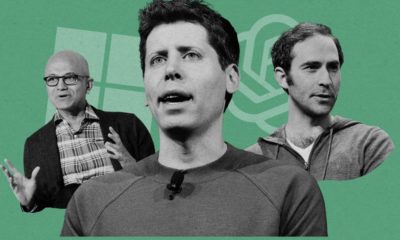Tech
Podcast: What’s AI doing in your wallet?
Published
3 years agoon
By
Drew Simpson
Our entire financial system is built on trust. We can exchange otherwise worthless paper bills for fresh groceries, or swipe a piece of plastic for new clothes. But this trust—typically in a central government-backed bank—is changing. As our financial lives are rapidly digitized, the resulting data turns into fodder for AI. Companies like Apple, Facebook and Google see it as an opportunity to disrupt the entire experience of how people think about and engage with their money. But will we as consumers really get more control over our finances? In this first of a series on automation and our wallets, we explore a digital revolution in how we pay for things.
We meet:
- Umar Farooq, CEO of Onyx by J.P. Morgan Chase
- Josh Woodward, Director of product management for Google Pay
- Ed McLaughlin, President of operations and technology for MasterCard
- Craig Vosburg, Chief product officer for MasterCard
Credits
This episode was produced by Anthony Green, with help from Jennifer Strong, Karen Hao, Will Douglas Heaven and Emma Cillekens. We’re edited by Michael Reilly. Special thanks to our events team for recording part of this episode at our AI conference, Emtech Digital.
Transcript
[TR ID]
Strong: For as long as people have needed things, we’ve… also needed a way to pay for them. From bartering and trading… to the invention of money… and eventually, credit cards… which these days we often use through apps on our phones.
Farooq: No one, 10 years ago, no one thought that, you know, you’d be just getting up from a dinner table and using Zelle or Venmo to send five bucks to your friend. And now you do.
Strong: The act of paying for something might seem simple. But trading paper for groceries…or swiping a piece of plastic for new clothes is built on a few powerful ideas that allow us to represent and exchange things of value.
Our entire financial system is built on this agreement… (and trust).
But this model is changing… and banks are no longer the only players in town.
[Sounds from an advertisement for Apple Card]
[Ad music fades in]
Announcer: This is Apple Card. A credit card created by Apple—not a bank. So it’s simple, transparent, and private. It works with Apple Pay. So buying something as easy as: *iPhone ding*.
Strong: It’s not just Apple. Many other tech giants are moving into our wallets… including Google… and Facebook…
[Sounds from Facebook’s developer conference]
Mark Zuckerberg: I believe it should be as easy to send money to someone as it is to send a photo.
Strong: Facebook Pay works through it’s social apps—including Instagram and Whatsapp—and executives hope those payments will one day be made with Facebook’s very own currency.
And beyond what we use to pay for things, how we pay for things is changing too.
[Sounds from an advertisement for Amazon One]
Announcer: Introducing Amazon One. A free service that lets you use your palm to quickly pay for things, gain access, earn rewards and more.
Strong: This product works by scanning the palm of your hand… and it’s not just for payments. It’s also being marketed as an ID. Something like this could one day be used to unlock the door at the office or to board a plane.
But letting companies use data from our bodies in this way raises all sorts of questions—especially if it mixes with other personal data.
Vosburg: We can see in great detail how people, for example, are interacting with their device. We can see the position in which they’re holding it. We can understand the way in which they’re typing. We can understand the pressure that’s being applied on the screen as people are hitting the keystrokes. All of these things can be useful with the combination of artificial intelligence to process the data to create sort of an interaction fingerprint.
Strong: I’m Jennifer Strong, and in this first of a series on automation and our wallets, we explore a digital revolution in how we pay for things.
[SHOW ID]
Farooq: So, if you think about how we operate today, we primarily operate through central authorities.
Strong: Omar Farooq is the CEO of Onyx… from J.P. Morgan. It focuses on futuristic payment products.
Farooq: Frankly, the biggest central authority in some ways is, in the US, for the money purpose, is the US federal reserve and the U S Treasury. You pull out a dollar bill. It says U S Treasury. It’s issued by the, you know, in some ways, quote-unquote, the top of the house. The top of the house guarantees it. And you carry it around with you. But when you give it to someone, you’re ultimately trusting that central authority in how you are transacting.
Strong: This can be a good thing. The value of that otherwise worthless paper bill is guaranteed because it’s issued and backed by the US government. But it can also slow things down. And though we now take for granted being able to transfer money in real time, the ability to do so hasn’t been around that long.
Farooq: Payments actually do, as a technology, evolve somewhat slowly. Just to give you an example, the U S recently, a couple of years back, launched the real-time payments scheme, which literally was the first new payments, you know, sort of, rails in the U S for decades. As crazy as that sounds.
Strong: A payment rail is the infrastructure that lets money move from one place to another. And those “real time payments” are a big deal because until recently when money left your account it took time, often days, before it reached its destination.
It’s why we can send money through apps like Venmo and hear the ding that it’s been received on the other person’s phone just a few seconds later. Also, Venmo’s chief competitor, called Zelle, only exists because of unprecedented cooperation between otherwise competing banks.
Farooq: I think where the world is going is towards more open platforms where it’s not just one party’s capabilities, but multiple parties’ capabilities that come together. And the value that is generated is by the ability for anyone to connect to anyone else. So I think what we are seeing is a rapid evolution in the digital sphere where more and more payment types, whether they are wholesale or retail are going into new modes, new rails, 24/7, 365, the ability to pay anyone anywhere in any currency. All those things are basically getting accelerated.
Strong: This is where cryptocurrencies could come in. Which isn’t just about digital money.
Farooq: We believe that there’s a path forward where money can be smarter itself. So you can actually program the coin and it can control who it goes to.
Strong: In other words, the trust we usually place in banks or governments would be transferred to an algorithm and a shared ledger.
Farooq: So you’re almost relying on that decentralized nature of the algorithm and say, “I think I can trust your token coming to me” because there’s, you know, X… X thousand or X hundred-thousand copies of a ledger that shows you as the owner of that token. And then when you give it to me, All those copies get updated. And now this shows me as the owner of that token.
Strong: And not only could this make payments faster and more seamless. It could also help people who’ve been largely excluded from the banking system.
Farooq: No matter what we do, we cannot really get around this Know Your Customer issue. And I think, you know, our view is that the tech is almost there, but the regulation and the infrastructure around it is not there yet. But, what we do want to do is we want to create these decentralized systems where these people can, over time, be included.
Strong: But sorting out the tech… is just one side of the coin. There’s also a need for better regulation.
Farooq: But I think it’s unfortunately a little bit more than what a bank could do. I think this.. some of these things rise to the level of like, you know, how does a government, or how does a state really enable identity at a global level? And I think that’s why when you look at China or you look at Nordics or some of those countries, I mean, you have national IDs and you have a very standardized method of knowing who someone is.
Strong: And the shift it allows in banking can be transformative…
Farooq: So if you look at a country like India, India has made dramatic progress in how many people have gone from being unbanked to banked in terms of having a wallet on their mobile phone. So I think these technologies are going to turbocharge people’s ability to come into this ecosystem. What I would hope as someone who grew up in the developing world before migrating here is that you would make those connections so, you know, everyone in those countries has access to markets—to bigger markets. So I mean, whether you’re sitting in Sub-Saharan Africa or you’re sitting in like, you know, a village in India or Pakistan or Bangladesh, wherever, you can actually sell something through Amazon and get paid for it. I mean, you know, those sorts of things. I think there’s tremendous potential human potential that could be unlocked if we could take payments in a digital manner to some of those parts of the world.
Strong: And this vision?… extends not only to connecting anyone, anywhere to a bank… but also anything with an internet connection.
Farooq: doing some initial R and D work in the IOT space, which is, if, you know, I mean, if one day your fridge had to order milk by itself. Like, does it have to go through your bank or could it just send the money to someone who’ll deliver your milk?
McLaughlin: Every device you use has potential to be a commerce device and our network brings that together.
Strong: Ed McLaughlin is president of operations and technology for MasterCard. He’s speaking at our A-I conference, EmTech Digital.
McLaughlin: So, what all of that connectivity results in? Is.. bringing together pretty much every financial institution in the world, tens of millions of merchants, governments, tech CO’s, and all of that, which results in billions of transactions a year we see. MasterCard across all of those devices and cards is serving about two and a half billion accounts. So we get the data and transactions from a Facebook sized population, if you think about that… And as far as the scope goes, we’ve been probably seeing 20 to 25% of all internet transactions outside of China—since there was an internet.
Strong: But this connectivity creates its own set of new problems. Maybe you’ve had the experience of going out of town and suddenly your card stops working because the change of location triggered a fraud alert.
McLaughlin: One of the keys in applying AI is how you frame the question and our teams very early on and said it wasn’t to stop transactions. It was to make sure as many good transactions as possible made it through.
Strong: Another key is to have an abundance of data.
McLaughlin: It’s a massive in-memory grid in our network that holds over 2 billion card profiles with about 200 analytical vectors on it. And we make decisions in every transaction that flows through. We have less than 50 milliseconds to make that decision. So in order to do that, we have 13 different AI technologies that we’ve modeled and experimented over the years that we apply to it.
Strong: Banks are also turning to A-I to look for money laundering. In the physical world, organized crime is often hidden behind the storefronts of real businesses. And in the digital world? Hiding is even easier.
Illegal money can quickly change hands dozens of times and cross borders until there’s no clear trail back to its source. It’s a massive problem. And most of it goes undetected. It’s possible only one percent of the profits earned by criminals gets caught. And the turmoil of the global economy over the last year has only made things worse.
McLaughlin: Our adversary.. They’re using AI too. And if you look online, it’s just bots fighting bots. So you have to pick up things you weren’t looking for before, like low and slow attacks where they stay inside, what looks like acceptable tolerances, but they’re constantly probing or doing a tumbler attack on your systems. Hard to pick up. When COVID hit, you know, the world moved online. Spending patterns shifted dramatically. And what we were able to do because the AI’s are rich enough and look at so many different variables.. We were able to really tell you’re still you and you’re just behaving a little bit differently.
Strong: And the types of attacks change too…
McLaughlin: So we saw one attack factor, which was pretty amazing is they thought, okay, people won’t block transactions for personal protective gear. It’s a specific merchant class we have. And we saw the fraudsters pile on in trying to get transactions through because they figured nobody would be blocking. The good news is we look at enough other elements that we could immediately pick that up and block those transactions.
Strong: They’re building machine learning tools to identify patterns of normal activity. And to flag outliers when they’re detected. Humans can then double check those alerts and approve or reject them.
McLaughlin: We constantly have AIs running also, not just blocking the fraud or looking at it, but I’m just calling it weirdness detection—where we’re constantly predicting what we would expect to see. In fact it’s a great way to step into AI because you have KPIs you’re already tracking. Try to start predicting them. When you see something which is an immediate deviation from it, the first thing we actually do is say, what’s going on here? So we may see something the model hasn’t caught up to, we just throw a rule to block it. And we can do that instantly.
Strong: The payments industry used to be slow moving… but it’s adapting to a world where any device might one day be connected to a payments network… including self driving cars.
McLaughlin: So whether you’re using your browser to order online, if it’s your iPhone, we’re using an Apple Pay to tap, or Mercedes just announced that, uh, they’re going to be connecting their cars to gas pumps. So you can simply drive up and authorize your transaction, right from your car. And in fact, as things move away from the card and to devices, we’re seeing even more data coming in through the network.
Strong: We’ll be back… right after this.
[MIDROLL]
Strong: With more and more of our financial lives being documented, tracked and mediated online, that data turns into fodder for AI—which is being enlisted into a whole host of other roles with payments.
Woodward: People have a really complex relationship with their money. It can be stressful. It’s often boring a lot of the time.
Strong: Josh Woodward leads the Google Pay team for the US. He sees it as an opportunity to change not just payments…but the entire experience of how people think about…and engage with…their money.
Woodward: And so what we’re trying to do as a team is think about how can we simplify that relationship with money where people feel in control and they feel confidence when they’re using our app and seeing how their spending is going in and out.
Strong: Google Pay began as a peer to peer payment solution—where the main goal was digitizing the plastic cards in your wallet. But over the years, it’s evolved into a tool meant to help you more holistically manage your finances, and relationships with businesses.
Strong: And it’s taken some cues from social media. Instead of card numbers or accounts, transactions are organized around pictures of people and businesses you’ve recently paid.
Woodward: We realized that transactions, in some ways, the.. the money, that the digits, the dollars and cents, is secondary. It’s a lot more about the person or the memory around that transaction. So we’ve tried to bring that out. Similarly, we’ve taken that same relationship based design and applied it to businesses. And this is something that’s very different. So when you look today at our home screen, // what you see is actually the icon of the business. And when you tap on that, you are taken to that business page where you can actually. Really see, like your relationship with the business. If you have a loyalty card you can see that there, you can see how your points are progressing. So the next time you go buy, you can get 20% off for example. And so we’ve tried to create this… Really almost like a threaded relationship of all your activity with that business inside the Google Pay app a little bit like Gmail, threaded email messages.
Strong: It also lets users sort transactions in a way that mirrors a web search.
Woodward: So you can do things like search for food. And you’ll get all of the transactions at places where you bought food and Google Pay can understand that this restaurant, for example, is a restaurant. You don’t have to go in and manually categorize that. Or you can get more specific and do things like a search for Mexican restaurants. And it’ll just take that subset of Mexican restaurants. There’s no part of that transaction that has the phrase, Mexican restaurant in it. Google Pay’s able to make that connection for you.
Strong: And using computer vision…it can sort through photos of receipts.
Woodward: What we’ve been able to do in Google Pay, again with someone’s permission, this feature is off by default, is that you can say, I want all the photos I’ve taken of receipts to be searchable in Google Pay. And what that allows you to do is actually search very specifically for individual items that are printed on the receipt. So for example, a couple of months ago, before Christmas, I bought a shirt, uh, it was a Christmas present from Lulu. I can go into Google Pay now and search for “shirt.” And that Lulu receipt comes up.
Strong: It’s designed to give users a greater sense of control over their spending.
Woodward: It creates a place where you get that full picture. And that’s what we’ve seen. Time and time again, in the research and in talking to people is that different apps have provided different slices of that picture, but being able to bring it all together is really what we aspire to.
[music transition]
Strong: It’s one more way our lives might become a little easier and more efficient with the help of technology… But also where the gathering… filtering… and processing… of vast amounts of personal data raises big questions… even before we get to things like paying with our faces or gestures… or how all of that data… might mix with the rest of our massive data trails.
And longer-term, what would it mean for companies like Facebook to establish their own currencies and take over the global payments system?
It’s worth asking whether we as consumers really get more control over our finances… or companies get more control over us…
[MUSIC IN]
Next episode…
Bennett: We couldn’t have imagined something like Siri or Alexa. You know we just thought we were doing just generic phone voice messaging… and so in 2011 when suddenly Siri appeared, it’s like, “I’m WHO??” [laughing]… “WHAT??”…
Strong: We look at what it takes to make a voice… and how that’s rapidly changing.
[CREDITS]
Strong: This episode was produced by Anthony Green, with help from Jennifer Strong, Karen Hao, Will Douglas Heaven and Emma Cillekens. We’re edited by Michael Reilly. Special thanks to our events team for recording part of this episode at our AI conference: Emtech Digital.
You may like
-


What’s next for OpenAI
-


What’s coming next for fusion research
-


The Download: junk in space, and what’s next for mRNA vaccines
-


Android 14 debuts: What’s new in Google’s latest mobile OS update?
-


What’s The Big Deal With Quest 3 Upper Body Tracking?
-


What’s changed since the “pause AI” letter six months ago?
Tech
The hunter-gatherer groups at the heart of a microbiome gold rush
Published
5 months agoon
12/19/2023By
Drew Simpson
The first step to finding out is to catalogue what microbes we might have lost. To get as close to ancient microbiomes as possible, microbiologists have begun studying multiple Indigenous groups. Two have received the most attention: the Yanomami of the Amazon rainforest and the Hadza, in northern Tanzania.
Researchers have made some startling discoveries already. A study by Sonnenburg and his colleagues, published in July, found that the gut microbiomes of the Hadza appear to include bugs that aren’t seen elsewhere—around 20% of the microbe genomes identified had not been recorded in a global catalogue of over 200,000 such genomes. The researchers found 8.4 million protein families in the guts of the 167 Hadza people they studied. Over half of them had not previously been identified in the human gut.
Plenty of other studies published in the last decade or so have helped build a picture of how the diets and lifestyles of hunter-gatherer societies influence the microbiome, and scientists have speculated on what this means for those living in more industrialized societies. But these revelations have come at a price.
A changing way of life
The Hadza people hunt wild animals and forage for fruit and honey. “We still live the ancient way of life, with arrows and old knives,” says Mangola, who works with the Olanakwe Community Fund to support education and economic projects for the Hadza. Hunters seek out food in the bush, which might include baboons, vervet monkeys, guinea fowl, kudu, porcupines, or dik-dik. Gatherers collect fruits, vegetables, and honey.
Mangola, who has met with multiple scientists over the years and participated in many research projects, has witnessed firsthand the impact of such research on his community. Much of it has been positive. But not all researchers act thoughtfully and ethically, he says, and some have exploited or harmed the community.
One enduring problem, says Mangola, is that scientists have tended to come and study the Hadza without properly explaining their research or their results. They arrive from Europe or the US, accompanied by guides, and collect feces, blood, hair, and other biological samples. Often, the people giving up these samples don’t know what they will be used for, says Mangola. Scientists get their results and publish them without returning to share them. “You tell the world [what you’ve discovered]—why can’t you come back to Tanzania to tell the Hadza?” asks Mangola. “It would bring meaning and excitement to the community,” he says.
Some scientists have talked about the Hadza as if they were living fossils, says Alyssa Crittenden, a nutritional anthropologist and biologist at the University of Nevada in Las Vegas, who has been studying and working with the Hadza for the last two decades.
The Hadza have been described as being “locked in time,” she adds, but characterizations like that don’t reflect reality. She has made many trips to Tanzania and seen for herself how life has changed. Tourists flock to the region. Roads have been built. Charities have helped the Hadza secure land rights. Mangola went abroad for his education: he has a law degree and a master’s from the Indigenous Peoples Law and Policy program at the University of Arizona.
Tech
The Download: a microbiome gold rush, and Eric Schmidt’s election misinformation plan
Published
5 months agoon
12/18/2023By
Drew Simpson
Over the last couple of decades, scientists have come to realize just how important the microbes that crawl all over us are to our health. But some believe our microbiomes are in crisis—casualties of an increasingly sanitized way of life. Disturbances in the collections of microbes we host have been associated with a whole host of diseases, ranging from arthritis to Alzheimer’s.
Some might not be completely gone, though. Scientists believe many might still be hiding inside the intestines of people who don’t live in the polluted, processed environment that most of the rest of us share. They’ve been studying the feces of people like the Yanomami, an Indigenous group in the Amazon, who appear to still have some of the microbes that other people have lost.
But there is a major catch: we don’t know whether those in hunter-gatherer societies really do have “healthier” microbiomes—and if they do, whether the benefits could be shared with others. At the same time, members of the communities being studied are concerned about the risk of what’s called biopiracy—taking natural resources from poorer countries for the benefit of wealthier ones. Read the full story.
—Jessica Hamzelou
Eric Schmidt has a 6-point plan for fighting election misinformation
—by Eric Schmidt, formerly the CEO of Google, and current cofounder of philanthropic initiative Schmidt Futures
The coming year will be one of seismic political shifts. Over 4 billion people will head to the polls in countries including the United States, Taiwan, India, and Indonesia, making 2024 the biggest election year in history.
Tech
Navigating a shifting customer-engagement landscape with generative AI
Published
5 months agoon
12/18/2023By
Drew Simpson
A strategic imperative
Generative AI’s ability to harness customer data in a highly sophisticated manner means enterprises are accelerating plans to invest in and leverage the technology’s capabilities. In a study titled “The Future of Enterprise Data & AI,” Corinium Intelligence and WNS Triange surveyed 100 global C-suite leaders and decision-makers specializing in AI, analytics, and data. Seventy-six percent of the respondents said that their organizations are already using or planning to use generative AI.
According to McKinsey, while generative AI will affect most business functions, “four of them will likely account for 75% of the total annual value it can deliver.” Among these are marketing and sales and customer operations. Yet, despite the technology’s benefits, many leaders are unsure about the right approach to take and mindful of the risks associated with large investments.
Mapping out a generative AI pathway
One of the first challenges organizations need to overcome is senior leadership alignment. “You need the necessary strategy; you need the ability to have the necessary buy-in of people,” says Ayer. “You need to make sure that you’ve got the right use case and business case for each one of them.” In other words, a clearly defined roadmap and precise business objectives are as crucial as understanding whether a process is amenable to the use of generative AI.
The implementation of a generative AI strategy can take time. According to Ayer, business leaders should maintain a realistic perspective on the duration required for formulating a strategy, conduct necessary training across various teams and functions, and identify the areas of value addition. And for any generative AI deployment to work seamlessly, the right data ecosystems must be in place.
Ayer cites WNS Triange’s collaboration with an insurer to create a claims process by leveraging generative AI. Thanks to the new technology, the insurer can immediately assess the severity of a vehicle’s damage from an accident and make a claims recommendation based on the unstructured data provided by the client. “Because this can be immediately assessed by a surveyor and they can reach a recommendation quickly, this instantly improves the insurer’s ability to satisfy their policyholders and reduce the claims processing time,” Ayer explains.
All that, however, would not be possible without data on past claims history, repair costs, transaction data, and other necessary data sets to extract clear value from generative AI analysis. “Be very clear about data sufficiency. Don’t jump into a program where eventually you realize you don’t have the necessary data,” Ayer says.
The benefits of third-party experience
Enterprises are increasingly aware that they must embrace generative AI, but knowing where to begin is another thing. “You start off wanting to make sure you don’t repeat mistakes other people have made,” says Ayer. An external provider can help organizations avoid those mistakes and leverage best practices and frameworks for testing and defining explainability and benchmarks for return on investment (ROI).
Using pre-built solutions by external partners can expedite time to market and increase a generative AI program’s value. These solutions can harness pre-built industry-specific generative AI platforms to accelerate deployment. “Generative AI programs can be extremely complicated,” Ayer points out. “There are a lot of infrastructure requirements, touch points with customers, and internal regulations. Organizations will also have to consider using pre-built solutions to accelerate speed to value. Third-party service providers bring the expertise of having an integrated approach to all these elements.”
